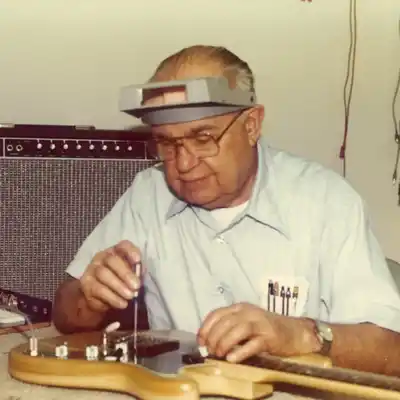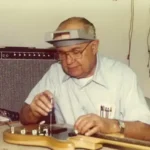
Leo Fender
In modern music, few individuals have had as profound an impact as Clarence Leonidas “Leo” Fender. His name has become synonymous with the electric guitar, an instrument that has become a symbol of an entire era of rock ‘n’ roll.
Leo Fender is probably the most influential luthier in the history of the electric guitar. But his story is not just about a luthier building guitars – it’s about an inventor who revolutionized music. He estimated that he has 50 to 75 patents to his name.
This is a comprehensive look at Leo Fender’s life from his humble beginnings to the rise of the Fender brand, and the legacy he left in the music industry.
Table of Contents
Early Life and Beginnings
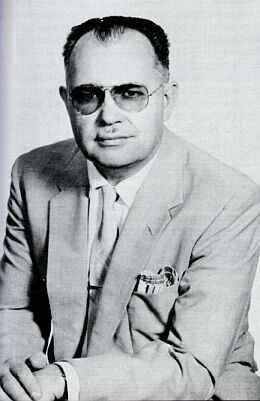
Clarence Leonidas (Leo) Fender was born on August 10, 1909, in Anaheim, California. Leo Fender grew up in a family of modest means, with his father working as a farmer and his mother as a bookkeeper.
Leo has shown an early interest in electronics, tinkering with radios and other devices from a young age. He later attended Fullerton Union High School, where he further honed his skills by building and repairing radios for friends and family.
After graduating from high school, Fender attended Fullerton Junior College, where he studied accounting, a skill that would later prove invaluable in his business ventures. However, his passion for electronics remained strong, and he continued to pursue this interest in his free time.
Between 1930 and 1947, Leo had a small shop for radio repairs and he supplied custom amplifiers and PA systems to musicians. Most of his customers were steel guitarists, who often complained about defects in existing pickups. Leo had already made improvements to automatic plate changers, for example, and now he decided to commit to designing better pickups and amplifiers.
The Birth of Fender Company
Leo soon started to build steel guitars and around 1944 he started experimenting with an electric, Spanish solid-body guitar. He used the pickup of his steel guitar for this. This prototype was rented out to country & western bands, whose musicians urged Leo to further develop and take the instrument into production.

Leo founded the company K&F; together with Doc Kauffman, a former employee of Adolph Rickenbacker (who owned the guitar company of the same name). K&F; made steel guitars and various amplifiers. Some famous amplifiers produced by Fender are Champ, Blackface Princeton, and the Vibrolux Reverb.
Kauffman left the company in 1944 and then became Fender Electric Instruments Co., consisting of Leo and six assistants. The sale was in the hands of Pacific Music Supply, Francis Hall, and various national organizations that were involved in giving steel guitar lessons.
Leo employed 15 people. But the company soon moved to a factory of 1200m², which was expanded again in 1949 to 1800m².
In 1953 they moved to a factory of just under 7000m². Leo also set up his own distribution organization, Fender Sales Inc., which was led by Donald D. Randall, now owner of Randall Instruments Inc.
In 1955 there were 55 employees, a number that grew to more than double in five years.
In 1959 new buildings were added, while in 1960 2000 m² extra floor space was added.
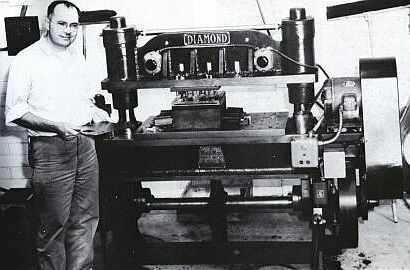
Because Leo Fender was the first to mass-produce guitars on an assembly line, he earned the nickname “Henry Ford of the guitar”.
Initially, Leo Fender was the chief technician, administrator, and sole owner of the entire business. Two of his assistants, Freddie Tavares and George Fullerton were not only skilled technicians and musicians but also made a significant contribution to Fender’s global popularity. Note to mention music like Rex Gallion and Bill Carson who contributed a not insignificant part to the development.
Fender has become one of the two companies (the other is Gibson) that set the tone for the world market of professional, electric guitars.
The Telecaster
In 1948, Leo Fender developed an instrument that would change the face of the music properly. This workhorse is one of the most popular electric guitars. Although the guitar is relatively cheap, it lasts a long time, and the fierce, sharp sound is extremely recognizable. The Telecaster is especially popular with country and rock musicians, but even jazz guitarists have one in the closet for rock sessions in the studio.
The first 1948 model he called the Esquire. It had only one pickup truck. He built an improved version with 2 pickups a year later and named it Broadcaster.

The Broadcaster was introduced in 1949. The name change had to do with the fact that the Gretsch company had a drum set with the name Broadkaster. For a while the guitar was released without a name, only the name Fender was sufficient. These guitars are now called ‘no-casters’ and are highly sought after by collectors.
In 2003 Gretsch was taken over by Fender and the name ‘Broadcaster’ came back on a special series of Telecasters.
The body was made of ash, while the removable neck was made of one piece of hard maple. The first Broadcasters had no tension bar which can be recognized by the fact that they do not have an elongated dark strip at the back of the neck. This dark strip of wood is used to fill the deep groove after the iron pin has been mounted in the neck. Fred Gretch had already used the name Broadcaster for one of his drum sets. Although Leo Fender was fairly certain that he could certainly use the name in the event of a conflict, he changed it to Telecaster, partly due to the emerging popularity of television.
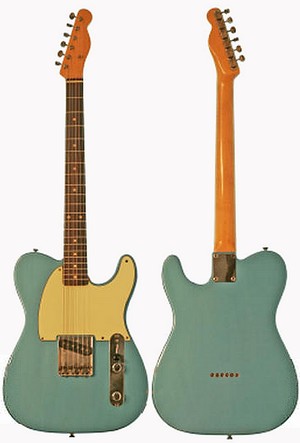
At the time, the first Telecasters cost around $189.00. They were identical to the Broadcaster and were mainly used by country & western guitarists. The sound could be controlled by a three-position switch, with which you could switch on the ‘solo element’ at the comb (front position), the ‘bass element‘ (middle position), or the same ‘bass element via a capacitor’ (rear position). The latter position produced a thumping sound that was suitable for playing bass parts. When switching from one position to the other, the volume also changes, sometimes making it necessary to adjust this by volume control.
After the invention of the bass guitar, the low booming sound became superfluous. A disadvantage was that it was not possible to combine the two pickups on the old models; and that is why changes were made in the mid-fifties, which had to make for a greater choice of settings: the shrill solo pickup alone, both pickups and the bass pickup. After a few years, the yellow copper comb was replaced by a chromed steel and at the end of the sixties the resistance of the potmeters was changed from 250 Kilo ohm to 1 Mega ohm.
Various changes were made at the beginning of 1955. The black one-piece bakelite pickguard was replaced by a white plastic one, the dome-shaped tone and volume buttons were flattened and the transparent lacquer became less transparent so that the wood structure was no longer visible. On the guitars from before the end of 1954, the Fender serial number can be found on the front near the treble pickup, while the neck mounting plate is blank; then the serial number is pressed onto the neck mounting plate. Fender started applying for serial numbers in 1950. See more about the Fender serial number.
Also, around 1954 the oval pickguard over the pickup selector was changed to the quadrangular plate that is still attached to it.
In addition to the well-known standard Telecaster, there are also different models, such as:
- De Esquire, introduced in 1954, a Telecaster without bass pickup and withdrawn from production after 1969.
- The Thin Line from the mid-sixties, hollow on one side and with one F-hole. In 1972 two humbuckers were mounted on the Thin Line.
- The Telecaster Custom from March 1970, with a humbucker as a bass pickup.
- The Rosewood Tele (1969, 1970, 1972).
- The Tele Deluxe from 1973, a new guitar with a rounded body, two humbuckers, and new frets and neck, making the strings slightly different from each other.
The decorative finish with feather and flower motifs was only available in 1969. From 1959 to 1969, the Telecaster and Esquire were delivered in a standard finish (custom finish), that is sunburst with a white binding at the edges. After 1969, the term Telecaster Custom refers to a new guitar with humbuckers.

Like most durable guitar models, the Tele has variations and special models that have been produced since the early 1950s. However, the standard no-nonsense Telecaster has remained largely the same, with two single-coil pickups, and a flat body of ash (later alder) that determine the unmistakable sound.
The Stratocaster
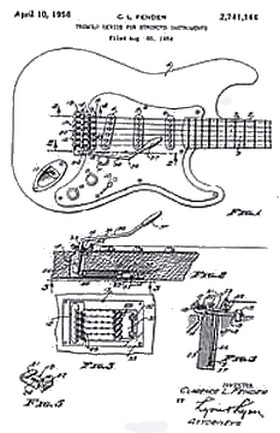
The Stratocaster was developed in the early 1950s and was introduced in the spring of 1954. It has become the most popular and copied guitar in the world. Among rock musicians, the Stratocaster is certainly one of the most loved guitars. It is probably partly thanks to its modern appearance that it is the only guitar with three pickups that are sold on a large scale. Due to the handy tremolo that was designed by Leo Fender himself, the Stratocaster is unrivaled in hard rock. Just like all current Fenders, Stratocaster bodies are nowadays made from ash wood.
In the beginning, three people can actually be considered as the founders of the ‘Strat’; Leo Fender, Freddie Tavares, and Bill Carson made special contributions to the guitar’s design. Freddie Tavares and Leo were designing from 1953 to 1954 when the first models were sold. They wanted something new, something special, something they had never seen in guitar territory.
They had the idea from the start to build a guitar with three pickups. The starting point was to design a good-sounding and playable guitar with a tremolo arm. This is partly to be able to compete with Bigsby. Bigsby had already produced guitars with tremolo that were sold well.
Fender’s first model of Stratocaster, including with tremolo, was sold for $249.50. Due to the modified shape of the body, the guitar was much more comfortable against your body than the sturdy Telecaster. Solid maple necks were standard until 1959; in 1960 a rosewood fret was added. In 1970, the customer was again able to get maple necks on request. The guitars, which were released before the middle of 1966, have a slightly narrower head than the current Stratocasters.
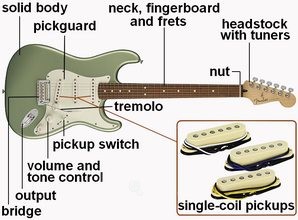

Tavares designed the headline (an example of his talent for combining practical utility with beauty) that all Fenders, with the exception of the Telecaster, are now equipped with.
The very first Stratocasters had a thick white plastic pickguard, made from one piece, but from 1959 all Stratocasters were fitted with a laminated black/white pickguard. In 1959 there were also some models with a gold anodized pickguard.
The original old Strats had a bone nut (nowadays made of ABS plastic), but the finishing method has been changed several times.
Old string holders, called ‘inertia blocks’ by Fender technicians, were made of steel; the current ones are cast iron.

The three pickups of the Stratocaster can be switched on separately; the fact that the selector switch can also be set in between two positions so that two pickups pick up the sound is a nice side effect that was not consciously designed by Leo and Freddie. This combination of two pickups produces a sound that is reminiscent of an out-of-phase tone.
From 1972, the Stratocasters and Telecasters have been equipped with humbucker pickups with the minimum angle adjustment. This allows you to adjust the angle of the neck with respect to the body with a small key that fits into a hole in the mounting plate at the back of the body. Via an identical construction just above the nut, you can also adjust the neck separately by pulling on the iron pin or relaxing.
Countless guitar players, including many famous names, made the Fender Stratocaster their daily tool. They already formed a legend around this instrument, long before there was even a successor.

Perhaps the most famous Stratocaster player has been ‘wizard’ Jimi Hendrix. In his hands, the Stratocaster sometimes seemed to lead a life of its own, and rarely would anyone have conjured such an impressive series of sounds and effects from one instrument. Hendrix perhaps gave Fender’s flagship the greatest fame by playing the blood-curdling version of the American national anthem on Woodstock in 1969 as a protest against the Vietnam War.
This Stratocaster, the ‘Olympic White’ from 1968 was sold in 1993 for a million dollars and later came for an unknown amount, but certainly higher, in the hands of Microsoft billionaire Paul Allan. The most expensive guitar ever?
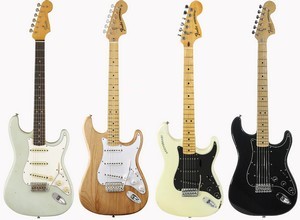
Hank Marvin cannot be forgotten either. He also played guitars from other brands, including instruments that bore his own name, but the typical Shadows sound was created with the help of the Stratocaster. Also on this list of Strato guitarists; are Ritchie Blackmore, Rory Galagher, Robin Trower, Eric Clapton, Mark Knopfler, Robin Robinson, Bob Dylan, and George Harrison. They are just a few of the many large and less legendary celebrities who have given the Fender Stratocaster its unique position in the world of popular music.
The Stratocaster is often mentioned together with the Gibson Les Paul, but due to the totally different character, these two can hardly be real competitors. A beautiful example of this is heard in Mike Oldfield’s “Moonlight Shadow,” in which the Strat and the Les Paul are in a duet.
The characteristic sound and timeless design make the Stratocaster a permanent trendsetter and many beginning guitarists dream of being able to play a real Stratocaster someday.
The Stratocaster is very popular and is often sold more than the Telecaster. And that, while the design has hardly changed since its introduction in 1954.
Younger generations are also going to work with it. It is so easy to replace a pickup or make changes that you can adjust the Stratocaster to your own taste. In addition, it is the most imitated guitar in the world.
Special models are specially priced: The ‘Strat 50th Anniversary Masterbuild’ has a price tag of just under six thousand dollars. It is an exact replica of the Stratocaster from 1954. On the occasion of the fiftieth anniversary of the Strat, Fender’s Custom Shop was also rebuilt under ‘Number One,’ the Stratocaster of the late Stevie Ray Vaughan.
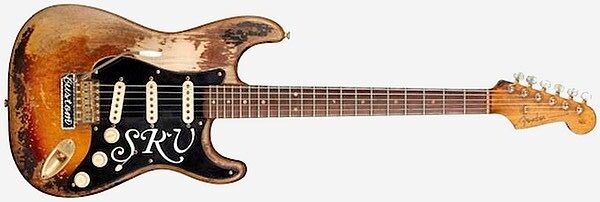
Fender naturally also has other solid bodies in its range. In 1956 the Duo-Sonic and the Musicmaster were introduced and renewed in 1964. The Duo-Sonic was taken out of production after 1969.
The Jazzmaster
After the introduction of the Telecaster in 1950 and the Stratocaster in 1954, Leo Fender wanted a new model guitar. It became the Jazzmaster, a further matured and thought-out design. At the end of 1957, the Jazzmaster was shown to the world.
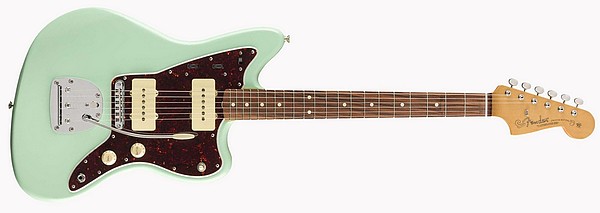
Although it may seem strange, the sound of the Jazzmaster is not very different from that of the Stratocaster. The first models had a small head, an anodized aluminum pickguard, black pickup caps, and chrome-plated cylindrical knobs. The model that came out at the end of 1959 also had a metal pickguard, but white buttons and white pickup caps.
The Precision Bass
This bass guitar changed the sound of popular music! Leo Fender recognized the need for an instrument to replace the hard-to-handle double bass and therefore developed the electric bass, which he called Precision.
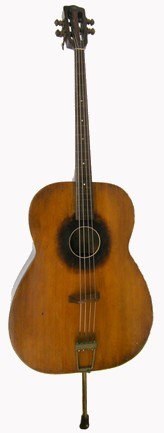
In 1956 an acoustic bass guitar had already been developed by the Chicago company Kay, but it never went into production. In the late 1930s, Regal Musical Instrument Company from Chicago introduced what you might call a bass ‘guitar.’ The Bassoguitar. The instrument was a cross between a flat acoustic guitar and a double bass and had a length of 1.80 m. Not very convenient to play a guitar.
The Precision cost $159.50 at the time. The advantages over the ‘doghouse’, as Leo called the double bass, are immediately noticeable. It’s smaller and sounds louder. Guitarists can now also handle a man-hour length of 85 cm. Another big advantage is that bass players can play the tones more precisely – hence the name ‘Precision Bass‘ – because the instrument is equipped with frets. The popular music industry immediately jumped out. Although several manufacturers had identical bass guitars, each electric bass guitar was called ‘Fender bass,’ even though it was a different brand. The Precision bass is still by far the most used bass guitar.

The first models that were produced in 1959 looked almost the same as the later Telecaster bass guitars. A few months after the Stratocaster was baptized (1954), the body took on the shape it still has today. However, the Telecaster pickguard, which covered the entire upper part of the body, was maintained, while the head was also of the Telecaster type.
The buttons were housed in a separate metal section. In 1957 the head took on the current shape, the well-known two-part pickup replaced the old single-coil, and the current pickguard, which also comes round, replaced the old one. The pickguard was made of anodized aluminum, but in 1960 they switched to plastic. Until 1959 maple necks were standard and from 1969 they were available again to order.
The Telecaster bass guitar appeared in 1968 and resembled the very first Precision. A large humbucker pickup was set up in February 1972 and various changes were made. A variant of the Precision is the fretless model from 1970 that was originally intended for double bass players but nowadays is also often played by bass guitarists. The sound is more sweet than the bass guitar and brighter than the double bass.
Perfect intonation is even more important on a fretless bass than on a normal one, because it is not the fret that defines the string but the finger, so with a minimal shift the tone becomes impure.
The advantages are that you can also play a quarter or even smaller distances on the fretless model. The sound is also easier to manipulate with the fingers because there is more direct contact with the string.
The Jazz Bass appeared in 1960 and had a body similar to the Jazzmaster, new pickups, and a narrower neck (over 3.5 cm). In 1966 it received a bound neck and a key with rectangular position marks.

Fender Acoustic Guitars
In 1962, Fender started producing acoustic guitars. The Kingman, Concert, Shenandoah, Villager, Newporter, Malibu, and Palomino were among the first series.
The Wildwood series had a back and sides of colored wood with swirling annual rings. These were built from 1966 to 1969. Then came the semi-acoustic Coronado and Antigua.
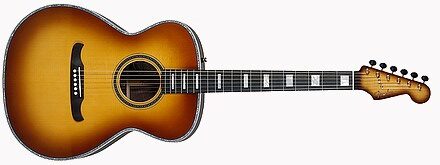
Amplifier Innovations
Leo Fender’s contributions to the world of music were not limited to electric guitars and basses; he was also a pioneer in the design and development of guitar amplifiers. Fender amplifiers were known for their clean, powerful tones and rugged, reliable construction, making them the perfect accompaniment to the company’s electric instruments.
One of Fender’s earliest amplifier designs was the Fender Deluxe, introduced in 1948. This compact combo amplifier, featuring a single 12-inch speaker, became a favorite among blues and country guitarists for its warm, clean sound and manageable size.
The Fender Twin, first released in 1952, represented a significant step up in power, with its dual 12-inch speakers and higher wattage. The Twin quickly gained a reputation for its crystal-clear clean tones and ample headroom, making it an ideal choice for many professional musicians.
Fender’s amplifier innovations continued throughout the 1950s and 1960s with the introduction of the Bassman, Vibrolux, and Super Reverb models, among others. These amplifiers became staples of the rock ‘n’ roll sound, beloved by musicians for their rich, full tones and natural overdrive when pushed to their limits. The unmistakable “Fender sound” played a crucial role in shaping the sonic landscape of popular music during this era.
Fender Experiments
Fender not only produces guitars but also pianos and harmonicas, among other things. Leo Fender introduced the Rhodes piano in the 60s. This instrument would have a great impact on the music world.
Although the original design was meant to replace the acoustic piano in rock concerts because of the heavy weight that they had to carry, the Rhodes started to live a life of its own thanks to its unique sound. Supertramp developed its own unmistakable style thanks to this instrument. 10cc (‘I’m Not In Love‘) also made world hits with the Fender Rhodes as a sound-determining instrument.
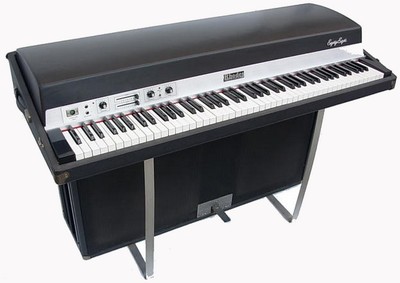
Leo Fender’s Last Venture
When Leo Fender had to stop working at the end of 1964 for health reasons, he decided to sell his factory. For 13 million dollars, the company was transferred to CBS in 1965, which caused a lot of unrest among guitar players.
For many, the designation pre-CBS has the magical sound that suggests that everything built after it would not actually be a real Fender. Of course, those rumors didn’t just come into the world and it is a fact that the CBS Company made some blunders, especially in the beginning.
For example, they stopped immersing the pickups in wax. Originally this was done to prevent unwanted resonances and feedback. That people couldn’t just stop doing it soon became apparent from the series of complaints about the sound of the guitars. The transistor amplifiers introduced in the late 1960s were never a success and disappeared from the program.
Against all this, it must be said that the constant quality from Fender to Fender, after the takeover, has improved considerably, and we should not forget that the efforts of CBS have made the Fender guitars accessible to a much larger audience. There were hardly any changes to the Stratocaster immediately after the acquisition. Since CBS, the ‘F’ from the Fender logo is smashed into the metal plate for the neck attachment.
After Leo sold his company to CBS in 1965, he founded a new company in 1966, called CLF Research, with which he continued to support CBS with advice until 1970.
From 1971, Leo worked with Forrest White and Tom Walker, both former employees of Leo from the Fender era and founders of the Music Man company 1971. In 1976 the first models designed by Leo and Forrest were released, including the StingRay Bass.
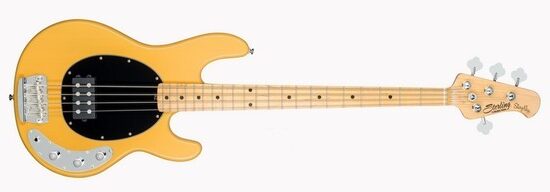
At the end of the 1970s, Leo quit CLF Research as a consultancy for CBS/Fender. He designed and produced original Music Man instruments for a while, but was looking forward to launching a new brand.
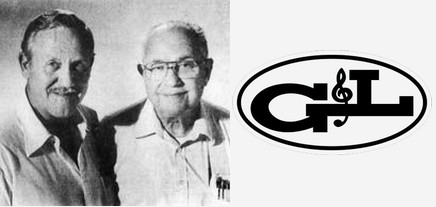
In 1980 it was time, together with George Fullerton (another old employee from the first hour), the company and brand G&L was founded. G&L instruments are high quality with advanced features derived from decades of experience and loved by musicians around the world. In 1991, G&L was taken over by the audio technology company BBE Sound.
Legacy and Impact
Leo Fender passed away on March 21, 1991, but his influence on the world of music endures. His contributions to the design and manufacture of electric guitars, basses, and amplifiers have left an indelible mark on music, shaping the sound of countless genres and inspiring generations of musicians.

From the Telecaster to the Stratocaster, Fenders has become synonymous with the sounds of rock ‘n’ roll, blues, country, and beyond.
Fender’s unwavering commitment to innovation and quality has cemented his place as one of the most influential figures in the history of music. His instruments have been embraced by some of the world’s most iconic musicians, including Jimi Hendrix, Eric Clapton, Stevie Ray Vaughan, and countless others.
Today, the Fender brand remains a cornerstone of the music industry, with their guitars, basses, and amplifiers continuing to define the sound of popular music.
